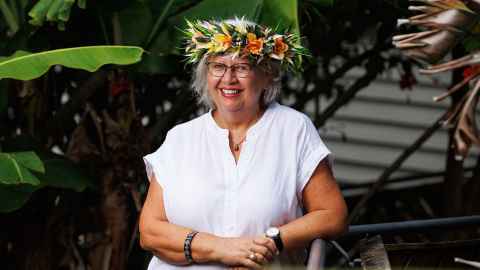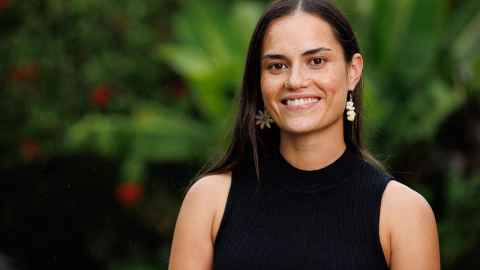Takaeang, Aranuka residents showcase climate resistance in Kiribati
11 July 2025
Communities in Kiribati show strong commitment to ‘staying in place’ despite environmental challenges.

Communities in Kiribati have shown a strong commitment to ‘staying in place’ despite having to consistently tackle environmental challenges.
I-Kiribati researchers have played a vital role in the University of Auckland’s Pacific Studies team investigating climate mobility.
Professor Yvonne Underhill-Sem MNZM, co-lead of the University’s research team, says the Pacific-wide, co-designed community-based project was funded by the Ministry of Foreign Affairs and Trade (MFAT). Working with local researchers was a critical feature of the project, including I-Kiribati researchers Robert Karoro, Tekateteke Metai and Roi Burnett.
Takaeang residents on Aranuka, a remote coral atoll in Kiribati, some 4,000 kilometres northeast of New Zealand, remain committed to staying in Takaeang. A mix of descendants from Aranuka and migrants from drought-prone southern islands in Kiribati, they have strong connections to their place.
Professor Underhill-Sem says they consistently and innovatively tackle environmental challenges, engaging in traditional collective decision-making to ‘stay in place’.
Aranuka holds a central place in Kiribati creation stories. At a sacred site on the island, a rock bears an indentation believed to be the footprint of Riiki, a mythical figure who, under the command of Nareau - the creator - lifted the sky from the earth. The name Ara-nuka, meaning ‘our centre’ reflects its role as the heart of the Gilbertese world.
In the 18th and 19th centuries, Aranuka held historical significance as part of a chieftainship era. During this time, both Aranuka and nearby Kuria (10 km west) were under the domain of the Uea (high chief) of Abemama, located about 40 km to the northeast.
Conflict in the late 19th century devastated Aranuka and Kuria’s populations. The Uea’s authority declined with colonisation and Christianity, giving way to traditional elder-led governance – a system still active today in Takaeang.
I-Kiribati researchers played a vital role in the University of Auckland’s Pacific Studies team investigating climate mobility.

Mobility is not new to I-Kiribati communities, whose ancestors first settled the small atolls of Kiribati from the west. Historical relocations include movements to Rabi in Fiji and Wagina in the Solomon Islands.
Despite climate-related challenges, the Takaeang community shows remarkable resilience. Their deep knowledge of local crops - pandanus, breadfruit, coconut, and babai (swamp taro) helps to supports food security.
When coastal erosion and king tides claimed the nearby islet of Bikentai, once home to a copra shed, the community adapted by harvesting and selling te ibo (seaworms). Underhill- Sem shared comments from a participant:
“Iai te kabaia man te kanaki arei, bwa e a rawata te ibo” — a blessing arose from the erosion.”
Drying and salting foods, a long-standing practice in Kiribati, especially in southern islands, helps communities prepare for drought and environmental stress.
Community decisions, including those about relocation, are guided by te botaki n unimwane - the council of male elders. When coastal erosion destroyed the teachers’ quarters at Takaeang’s primary school, the elders swiftly relocated them inland in just a single day to avoid disrupting education.
This elder-led governance continues to serve Takaeang well, enabling timely, community-driven responses to climate threats. The commitment to social cohesion and sustainability highlights the importance of supporting local decision-making in climate mobility planning.
This is how they stay in place, says Underhill-Sem.
Media contact
Kim Meredith | Pacific media adviser
M: 0274 357 591
E: kim.meredith@auckland.ac.nz